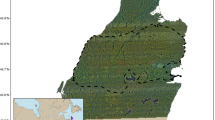Abstract
We examined the temporal and spatial patterns of feeding behaviours of muskoxen during winter in the High Arctic. Pawing motions (to uncover forages beneath snow cover) were strongly aggregated into temporal bouts. Similarly, feeding stations (areas exploitable without motion of the forelegs) were aggregated into spatial patches. Muskoxen responded to greater snow accumulation at feeding sites by increasing the rates of pawing, rates of pawing bouts, number of pawing strokes per bout, and station residence times. Patch residence times showed little relationship to snow or forage abundance because, as muskoxen increased station residence times, they decreased the number of stations per patch. Muskoxen displaced one another from feeding stations more frequently as snow thickness and group size increased. Time spent at feeding stations was positively correlated to travel costs, in accordance with the marginal value model of patch residence. The model was not supported, however, at the scale of the feeding patch. The results indicate that behavioural responses of muskoxen to foraging conditions differ across scales.
Similar content being viewed by others
References
Baharav D, Rosenzweig ML (1985) Optimal foraging in Dorcas gazelles. J Arid Environ 9:167–171
Berdoy M (1993) Defining bouts of behaviour: a three-process model. Anim Behav 46:387–396
Charnov EL (1976) Optimal foraging: the marginal value theorem. Theor Popul Biol 9:129–136
Collins WB, Smith TS (1991) Effects of wind-hardened snow on foraging by reindeer (Rangifer tarandus) Arctic 44:217–222
Fancy SG, White RG (1985) Energy expenditures by caribou while cratering in snow. J Wildl Manage 49:987–993
Ferguson MAD, Gauthier L (1992) Status and trends of Rangifer tarandus and Ovibos moschatus populations in Canada. Rangifer 12:127–141
Goddard J (1968) Food preferences of two black rhinoceros populations. East Afr Wildl J 6:1–18
Gray DR (1987) The muskoxen of Polar Bear Pass. Fitzhenry and Whiteside, Markham, Ontario
Hard DC (1992) The effect of wolf predation and snow cover on musk-ox group size. Am Nat 139:190–204
Jarman PJ (1974) The social organization of antelope in relation to their ecology. Behaviour 48:215–267
Jiang Z, Hudson RJ (1993) Optimal grazing of wapiti (Cervus elaphus) on grassland: patch and feeding station departure rules. Evol Ecol 7:488–498
Kacelnik A, Houston AI (1984) Some effects of energy costs on foraging strategies. Anim Behav 32:609–614
Kotliar NB, Wiens JA (1990) Multiple scales of patchiness and patch structure: a hierarchical framework for the study of heterogeneity. Oikos 59:253–260
Krebs JR, Houston AI, Charnov EL (1981) Some recent developments in optimal foraging. In: Kamil AC, Sargent TD (eds) Foraging behavior: ecological, ethological, and psychological approaches. Garland STPM Press, New York, pp 3–18
Machlis L (1977) An analysis of the temporal patterning of pecking in chicks. Behaviour 63:1–70
Mayes E, Duncan P (1986) Temporal patterns of feeding behaviour in free-ranging horses. Behaviour 96:105–129
Melton DA, Gates CC, Larter NC, Virgl JA (1990) Foraging behaviour of wood bison in an expanding population. Trans Int Union Game Biol Congress 19:44–47
Novellie PA (1978) Comparison of the foraging strategies of blesbok and springbok on the Transvaal highveld. S Afr J Wildl Res 8:137–144
Oakes EJ, Harmsen R, Eberl C (1992) Sex, age, and seasonal differences in the diest and activity budgets of muskoxen (Ovibos moschatus). Can J Zool 70:605–616
Oleson CR, Thing H (1989) Guide to field classification by sex and age of the muskox. Can J Zool 67:1116–1119
Owen-Smith N, Novellie P (1982) What should a clever ungulate eat? Am Nat 119:151–178
Raillard M (1992) Influence of muskox grazing on plant communities of Sverdrup Pass (79°N), Ellesmere Island, N.W.T., Canada. PhD thesis, University of Toronto, Toronto
Risenhoover KL, Bailey JA (1985) Relationships between group size, feeding time, and agonistic behavior of mountain goats. Can J Zool 63:2501–2506
Ruyle GB, Dwyer DD (1985) Feeding stations of sheep as an indicator of diminished forage supply. J Anim Sci 61:349–353
SAS Institute (1990) SAS/STAT user's guide, version 6, 4th edition. SAS Institute, Cary, NC
Schaefer JA, Messier F (1994) Composition and spatial structure of plant communities on southeastern Victoria Island, arctic Canada. Can J Bot 72:1264–1272
Sibly RM, Nott HMR, Fletcher DJ (1990) Splitting behaviour into bouts. Anim Behav 39:63–69
Skogland T (1978) Characteristics of the snow cover and its relationship to wild mountain reindeer (Rangifer tarandus tarandus L.) feeding strategies. Arct Alp Res 10:569–580
Slater PJB (1974) The temporal pattern of feeding in the zebra finch. Anim Behav 22:506–515
Slater PJB, Lester NP (1982) Minimising errors in splitting behaviour into bouts. Behaviour 79:153–161
Stephens DW, Krebs JR (1986) Foraging theory. Princeton University Press, Princeton, NJ
Thing H (1977) Behavior, mechanics and energetics associated with winter cratering by caribou in northwestern Alaska. (Biol Biological Paper 18) University of Alaska, Fairbanks
Thing H, Klein DR, Jingfors K, Holt S (1987) Ecology of muskoxen in Jameson Land, northeast Greenland. Holarct Ecol 10:95–103
Vandal D, Barrette C (1985) Snow depth and feeding interactions at snow craters in woodland caribou. Proc 2nd North Am Caribou Workshop, McGill Subarct Res Pap 40:199–212
Ward D, Saltz D (1994) Foraging at different spatial scales: Dorcas gazelles foraging for lities in the Negev Desert. Ecology 75:48–58
Author information
Authors and Affiliations
Rights and permissions
About this article
Cite this article
Schaefer, J.A., Messier, F. Winter foraging by muskoxen: a hierarchical approach to patch residence time and cratering behaviour. Oecologia 104, 39–44 (1995). https://doi.org/10.1007/BF00365560
Received:
Accepted:
Issue Date:
DOI: https://doi.org/10.1007/BF00365560




